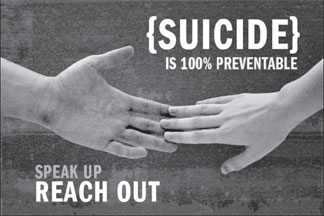|
September 10 - World Suicide Prevention Day:
Stigma: A barrier to suicide prevention
by S. Weragoda
“Poor people in
developing countries survive and often find pleasure in their hard
lives. There are few suicides in the poorest countries. Who has time for
suicide? You’re too busy surviving.”
David
C. Colander, Professor of Economics at Middlebury College
The feeling of disappointment is a part of human nature, it is said.
It is weakness of facing up to it or overcoming it that becomes the
underlying factor of a person’s character.
 While the world will be observing the World Suicide Prevention Day on
September 10 to promote worldwide action to prevent suicides, many
believe it is still a moot point to identify the best method to overcome
the increasing global suicides and raise awareness that suicide is a
major preventable cause of premature death. While the world will be observing the World Suicide Prevention Day on
September 10 to promote worldwide action to prevent suicides, many
believe it is still a moot point to identify the best method to overcome
the increasing global suicides and raise awareness that suicide is a
major preventable cause of premature death.
This year’s World Suicide Prevention Day theme is Stigma: A Barrier
to Suicide Prevention.
World Suicide Prevention Day, which first started in 2003, is held
annually on September 10. While the World Health Organisation (WHO)
takes a leading role to co-sponsors this event, World Suicide Prevention
Day aims to raise awareness that suicide is preventable, spread
information about suicide awareness, decrease stigmatisation regarding
suicide and improve education about suicide.
Males
It is estimated that about one million people around the world commit
suicide every year. There are people all over the world who feel so low
that suicide seems like the only way out. But there is always another
way - and we can tackle it together!
It has been recorded that males aged 40-59 are most at risk for
suicide.
In 2009, 1,361 men in this age group died by suicide in Canada.
However, incidence of suicide tends to be under-reported due to both
religious and social pressures, and possibly completely unreported in
some areas.
Suicide rates have shown a steady increase over the past 50 years and
are projected to increase to 1.53 million by the year 2020. This is in
spite of significant advancements in recognition and treatment of
depression and other mental disorders, the introduction of more
effective and safer psychotropics (including anti-depressants) and
improvement in mental health services in many countries. However, in
countries such as Finland and England suicide prevention programs have
successfully lowered suicide rates.
 Incidence of suicide is usually reported as rates per 100, 000. It is
reported that countries with rates of more than 30/100 000 are
considered high rates countries; those with rates between 10–29/100 000
as middle rates countries and those with rates less than 10/100 000
(e.g. Egypt, Jordan) as low rates countries. Rates, however, do not
always reflect the true extent of the problem. Incidence of suicide is usually reported as rates per 100, 000. It is
reported that countries with rates of more than 30/100 000 are
considered high rates countries; those with rates between 10–29/100 000
as middle rates countries and those with rates less than 10/100 000
(e.g. Egypt, Jordan) as low rates countries. Rates, however, do not
always reflect the true extent of the problem.
On average, nearly 3,000 people commit suicide daily, according to
WHO. For every person who completes a suicide, 20 or more may attempt to
end their lives. About one million people commit suicide each year.
Suicide is a major preventable cause of premature death which is
influenced by psycho-social, cultural and environmental risk factors
that can be prevented through worldwide responses that address these
main risk factors.
Evidence
There is strong evidence indicating that adequate prevention can
reduce suicide rates.
Mortality Database 85 percent of suicides in the world occur in low
and middle income countries, though data are unavailable for 73 percent
of these countries, says a WHO report. Overall there are no data on
suicide for more than half of the world’s countries, most of which are
developing countries in Asia, Africa and South America.
Suicide is no longer a criminal offence in any developed country but
continues to be so in many developing countries, especially in many
Islamic countries. Religious and social factors also continue to
influence the diagnosis and registering of suicides. Families do not
disclose the true nature of the act, for fear of harassment by police
and/or social stigma.
A number of effective prevention programs and guidelines has been put
in place in various places throughout the world.
One cannot comprehend the statistics behind the high rate of suicide
in high income countries. Numerous studies have shown that Denmark and
Sweden that consistently score high on measures of happiness and life
satisfaction also have relatively high suicide rates. Some social
scientists speculate that the trends are probably unrelated and can be
explained by regional factors like dark winters or cultural differences
regarding suicide.
 |
 |
|
Reaching out in their hour of need can
stem suicides to an extent |
More Americans commit suicide compared to car accidents, according to
the Centres for Disease Control and Prevention, a disturbing statistic
that some experts say points to the true depths of the US economic
crisis.
From 1999 to 2010, the suicide rate among US citizens between 35 to
64 soared by about 30 percent, to 17.6 deaths per 100,000 people, a jump
from 13.7. Economists from the Federal Reserve Bank of San Francisco,
the University of Warwick in England and Hamilton College in New York
examined life satisfaction scores provided by 2.3 million Americans
state by state, compared to state suicide rates. Utah, for example,
ranks highest in life satisfaction - but also has the ninth highest
suicide rate in the U.S.
The largest economies in Asia also have the highest suicide rates in
the region with South Korea, China and Japan leading. South Korea,
identified as one of the G-20 major economies is a high-income developed
country and a member of OECD of which it is the most highly
industrialised. South Korea has the highest suicide rate among the 30
OECD countries, with the toll of suicide deaths doubling in the last
decade with a suicide rate of 31.7 per 100,000.
On September 10 2013, the International Association for Suicide
Prevention will appeal to the public to mark the Day by lighting a
candle at 8.00pm and placing it in a window to show support for World
Suicide Prevention Day and suicide prevention across the world. |


